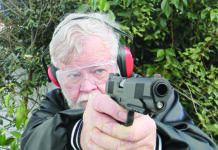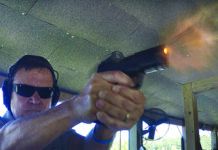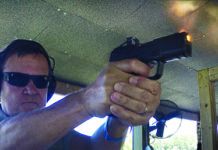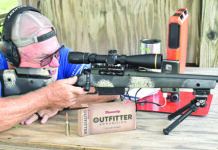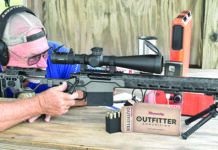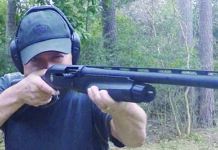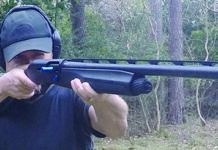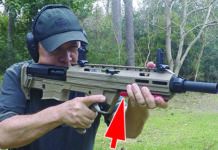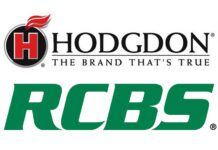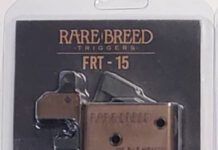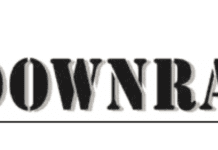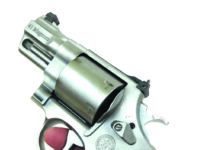Test of CZ PCR
I found the recent article on the CZ PCR 9MM pistol (May 2000) interesting and informative, though I would like to respond to some of the points made in the article.
It was stated that the trigger on the PCR was rough before it broke. As with most DA/SA pistols, the mechanism required to operate the ignition system is somewhat complex when compared to a single-action only or double-action only. When related to other models of a similar design, the CZ trigger is an excellent balance of single and double action.
As to the malfunctions: The PCR is one of the newest variants of the Classic CZ 75 pistol. It was designed with the law-enforcement market in mind. With its compact dimensions and alloy frame, it is easy to carry. It was selected as the issue arm for the Czech Republic police over other models and manufacturers. In the selection process the PCR was tested in all types of environments and conditions to evaluate the function and reliability of this pistol. The PCR won the competition and is now the issue sidearm of the Czech Police. The example you tested, for some reason, did not perform as it should.
There may be several reasons for this, including ammunition used, a defective magazine, or a damaged slide-stop spring. Each CZ firearm is tested in the factory for function and accuracy using at least two full magazines of ammunition to reduce the possibility of malfunction. One other factor is the tight slide-to-frame fit. As the CZ pistols have a full slide-to-frame fit, there is a close interface between these surfaces that may require a period of breaking in. No matter what the reason, the pistol should function, and if a customer purchased a CZ pistol that did not function as it should, we will make sure it’s taken care of by our service department.
As to the plastic guide rod, our feelings are that we wanted the lightest pistol possible and have had good success with the plastic guide rods in the past, so it was chosen as the best for the application. The plastic guide rod has a life in excess of 10,000 rounds. If the customer wishes, we do have metal ones available as an aftermarket item.
CZ’s goals are simple; supply the best possible firearms for shooters and law enforcement at reasonable prices and give excellent customer service. We feel that the PCR is an excellent choice for those who are interested in a compact pistol with proven design and reliability.
Thank you for the opportunity to give the CZ side of the story. Your magazine is a real value to the shooting public.
Steven Langford
Managing Director
CZ-USA
Barrel Testing Comments
I generally agree with your very informative data on the products tested in Gun Tests, though I have disagreed with you on two occasions because of my own experience with the products you gave a negative report on. This time I must respond. Having several years of experience in tuning and accurizing 1911-style firearms, I must take exception to two points in your 1911 barrel evaluation article in the May 2000 issue. The first step one must take in the process of obtaining optimal accuracy from any 1911 pistol is the proper tight, uniform fitting of the slide to the frame.
Also. I have had great success with every Storm Lake Machine barrel that I have ever fitted to any custom-built 1911 I have ever made.
Additionally, anyone who is unconsious enough to double-charge a case deserves to have his barrel disintegrated. Reloading is not for idiots—they should buy ammo instead.
Phil Worrill
via Internet
Since the publication of our article on the .45 barrels, I have worked extensively with the Robar test gun now fitted with the Nowlin barrel. I conditionally agree with your comment regarding the fit of slide to frame, in that it seems to be necessary if one is after optimal results. The Robar gun, when fitted with the Nowlin barrel, achieved very good accuracy, but had an occasional high and/or low shot in each group. Tightening the slide to the frame seems to have eliminated that, but we’re still testing. The fantastic results we obtained with the old Colt tends to disprove this, however, as we did no slide tightening whatsoever.
It’s good to know that you’ve had great success with Storm Lake barrels. Ours, however, was 0.032 inch out of spec in the distance from the back of the barrel to the top lug cuts, could not be fitted to any 1911, and was thus junk. If we had time we would have tried a different sample. However, that barrel ought not to have ever left the factory, and because it did we are obliged to tell that to our readers.
Concerning double charges, this is very easy to do if you have a progressive press. We use the superb Dillon 550B for assembing many test loads here in Idaho. Occasionally, a .45 ACP case with a too-tight primer pocket gets into the press and the primer fails to seat properly. Taking the case out and reinserting the next one could result in a double powder charge if you didn’t pay close attention. This is not necessarily the act of an idiot.
We know several world-class shooters who have handloaded more than 100,000 rounds of .45 ammo. That they might have got only one double charge out of this quantity is close to miraculous. The new and inexperienced reloader has a greater chance of getting a double powder charge. We can’t suggest they quit reloading, but we can suggest they learn from the experiences of others. We published the information Don Fisher gave us so the reader would 1) know about it, and 2) have an option (chrome-moly barrel) that might prevent excessive damage and personal injury.
Ray Ordorica
Custom Combat .45 ACP Pistols
Kudos to Gun Tests for an objective, no-nonsense evaluation of three high-end .45 ACP pistols (April 2000). It continually amazes me how some of the big-name shops charge top dollar, make a customer wait, and then ship a product that doesn’t work. As someone who has owned, shot, and carried single-action .45 ACPs of the Colt design for more than 20 years, here’s my recent “poor person’s” approach to getting a topnotch defensive pistol:
First, I purchased a Colt 1991A1 through the Colt/NRA Instructor Purchase Program for $326, delivered to my local dealer. Due to Colt’s ongoing management woes, it’s unlikely that they will repeat this offer, but if you look hard enough you can find good condition used stock .45s in the $300 to $350 range.
Out of the box, I was pleasantly surprised that the 1991A1 was tight, had a crisp (if heavy) trigger, and shot one-hole groups at 50 feet offhand with any ammo I put through it. I was unpleasantly surprised that every edge on the gun was sharp enough to shave with.
I then took the gun to my long-time gunsmith, Karl Sokol of Chestnut Mountain Sports in West Rutland, Vermont. Sokol has been smithing for me for close to 15 years. He’s a former law-enforcement officer who knows what should be done to a carry pistol and what is superfluous.
Sokol is also a rarity these days —a one-person operation. His work for me has been nothing less than perfection. The modifications I had done to the 1991A1 were:
• Replaced the plastic trigger and mainspring housing with steel;
• Adjusted the trigger down to 4.5 to 5.0 pounds;
• Installed a dovetailed and pinned front sight machined to my height and width specifications;
• It was also drilled and embedded with a IWI tritium green dot;
• Installed a Novak low-mount rear sight drilled and embedded with an IWI tritium green bar;
• Installed an Ed Brown beavertail grip safety, Commander hammer, and narrow ambidextrous safety;
• De-horned or melted all sharp external edges;
• Beveled the mag well and ejection port;
• Refinished the entire gun with Parkerizing;
• Installed a set of black micarta grips.
Total for this work came to about $725 about a year ago. With the cost of the original 1991A1, that yield a project cost in the $1,050 range. The finished product makes me look like I know what I’m doing on good days. Specific modifications I did not have done, and why:
20- or 30-line per inch front and/or back strap checkering: I have found that the sharp checkering eats up dress shirts and suit coat linings rapidly. Also, checkering doesn’t make a bit of difference if you’re holding onto the gun with a good hard hold. If you are holding as hard as you should, really sharp checkering can hurt or abrade the hand.
Front cocking serrations on the slide, ostensibly to press-check the chamber: This technique depends on visual verification and is therefore useless in the dark. (Unless you routinely wear night vision gear or fire up your Surefire 6P and tell the whole world where you are.) Learn the tactile chamber check technique as taught at Clint Smith’s school and the front serrations quickly become more expensive ornamentation.
Final thoughts? Well, on average, police officers who are required to fire qualification at least once a year miss their intended target when the “real thing” goes down about 85 percent of the time. Take the dollar amount you spend on your primary handgun and modifications, multiply it by 5, and spend that on practice ammo. Take the same base figure and multiply it by 10 and spend that on getting some top-notch training. Clint Smith says it all: “It’s not the gun. It’s never the gun. It always has, and will always be, the operator.”
B. Kurata
New Hampshire
Amen to your comments, especially concerning training first, and practice after you’ve learned what you need to practice.
Press-checking, for those unfamiliar with the term, is verification of a round in the chamber by pressing the slide partially rearward and either looking or feeling for it. Early-on, this was commonly done by inserting the thumb of the weak hand into the trigger guard and placing the index finger directly beneath the muzzle, and then pinching the slide partially open. Clumsiness occasionally caused the thumb to trip the trigger, leading to a scorched (or worse) index finger. Someone discovered it was safer to place the weak hand under the trigger guard and grasp the front of the slide with opposing thumb and fingers and pull it rearward. Forward serrations made that easier, particularly when stiffer-than-normal recoil springs were installed. Tactile checking is accomplished by feeling for the chambered round with the trigger finger, and that can be accomplished no matter how the slide is withdrawn.
Ray Ordorica
Marlin 80 DL Memories
I enjoyed your test of the Marlin 80 DL in the March 2000 issue, since it was my first rifle which I got sometime in the early fifties. I was given the gun without the clip for the first year because my father wished me to learn to make the first (only) shot count.
On the article itself, I have two comments. First, my Marlin was not equipped with the Lyman 57 rear sight. The factory effort was quite poor, with elevation adjustment being accomplished by loosening a knurled nut and moving a sheet-metal stamping, then tightening the nut. Windage was adjusted by loosening two screws and moving the aperture by guess and by gosh. I soon replaced it with a Williams 5D, which was $5 then.
You will notice the front sight ramp has a groove on each side to accommodate the slip-on hood, which seems to be missing in your photos. I often had mine pulled off while pulling the gun from its case. The manual supplied with the gun cautioned against shooting shorts or longs, as they would foul and erode the chamber, they said. They were certainly correct about the fouling, but I’m not sure about the erosion. At any rate, it seems to have been designed to feed only Long Rifle cartridges, and would not feed well with anything else. I did, however, use BB and CB caps for vermin control with no apparent harm to the gun.
Your article made me miss the Marlin.
Bill Henneberg
@yahoo.com



